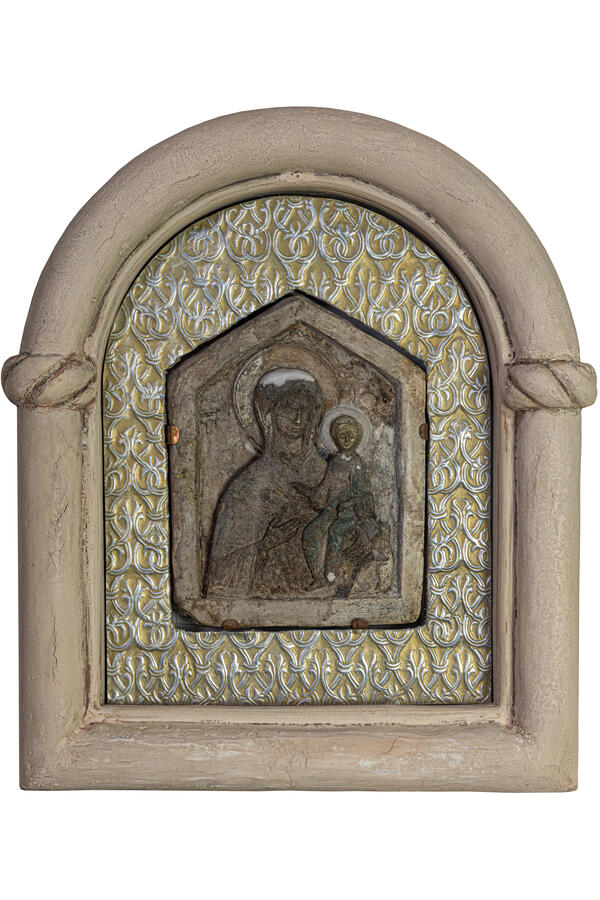The stone Smolensk Icon of the Mother of God “Hodegetria” is a unique exhibit in the collection of the Sergiev Posad Museum-Reserve. This is the only known stone icon of the 15th century. Probably, the architect Vasiliy Ermolin, who worked at the Trinity-St. Sergius Monastery in the 1460s-1470s, was involved in its creation. Ermolin is also credited with creating stone statues of St. George the Victorious and St.Demetrius of Thessaloniki on the Frolov (Spasskaya) Tower of the Moscow Kremlin.
In 1469 Vasiliy Ermolin built in the Trinity-St. Sergius Monastery the stone buildings of “trapeznaya” (refectory) and “povarnya” (kitchen).
Probably, the stone icon of the Mother of God was also created at the same time.
The iconographic type “Hodegetria” (translated from Greek as the “Guide”) is one of the most common images of the Mother of God. In such icons she is depicted with the infant Jesus sitting on her lap. His right hand is raised in a gesture of blessing, and the Mother of God points to Christ.
In Russian art, three-dimensional images of Jesus Christ, the Mother of God and saints were rare. Statues and bas-reliefs were more typical of Catholic churches. The stylistics of this image of the Mother of God testifies to the Western influence, which is also expressed in the preserved statue of St. George the Victorious. The authorship of these two works has not yet been established for certain.
According to the monastic inventories of 1641 and 1701, the icon was located in the iconostasis of the Trinity Cathedral. In 1730, another source noted that this image was located on the wall of one of the stone chambers built by Vasiliy Ermolin. Records with the stories of the monastery’s old-timers said that in 1730 the icon cured the psalm reader Kuzma Matveev, whose “hands were bent to the back and withered.” The psalmist was brought to the palace of Empress Anna Ioannovna, where he was examined by the doctors who had been checked by the Empress.
In honor of the miraculous icon, first a chapel was built, and in 1746-1748 — the Smolensk Church of the Trinity-St. Sergius Lavra. It was consecrated in the presence of Empress Elizaveta Petrovna in 1753. The stone icon was in this temple until 1920, and then it entered the museum collection.
When the precious casing was removed from the image, it turned out that the head of the Christ Child was lost. It probably broke off in the 18th century, when the icon was moved from the wall to the temple. Instead, a wooden plug was inserted into the icon, painted and covered with a thick layer of mastic. In 1949, the icon was transferred to the All-Russian Art Research and Restoration Center named after Academician I.E. Grabar. The head of Jesus Christ was recreated here by 1975.
After returning from the workshops, the image is constantly in the historical exhibition of the museum.
In 1469 Vasiliy Ermolin built in the Trinity-St. Sergius Monastery the stone buildings of “trapeznaya” (refectory) and “povarnya” (kitchen).
Probably, the stone icon of the Mother of God was also created at the same time.
The iconographic type “Hodegetria” (translated from Greek as the “Guide”) is one of the most common images of the Mother of God. In such icons she is depicted with the infant Jesus sitting on her lap. His right hand is raised in a gesture of blessing, and the Mother of God points to Christ.
In Russian art, three-dimensional images of Jesus Christ, the Mother of God and saints were rare. Statues and bas-reliefs were more typical of Catholic churches. The stylistics of this image of the Mother of God testifies to the Western influence, which is also expressed in the preserved statue of St. George the Victorious. The authorship of these two works has not yet been established for certain.
According to the monastic inventories of 1641 and 1701, the icon was located in the iconostasis of the Trinity Cathedral. In 1730, another source noted that this image was located on the wall of one of the stone chambers built by Vasiliy Ermolin. Records with the stories of the monastery’s old-timers said that in 1730 the icon cured the psalm reader Kuzma Matveev, whose “hands were bent to the back and withered.” The psalmist was brought to the palace of Empress Anna Ioannovna, where he was examined by the doctors who had been checked by the Empress.
In honor of the miraculous icon, first a chapel was built, and in 1746-1748 — the Smolensk Church of the Trinity-St. Sergius Lavra. It was consecrated in the presence of Empress Elizaveta Petrovna in 1753. The stone icon was in this temple until 1920, and then it entered the museum collection.
When the precious casing was removed from the image, it turned out that the head of the Christ Child was lost. It probably broke off in the 18th century, when the icon was moved from the wall to the temple. Instead, a wooden plug was inserted into the icon, painted and covered with a thick layer of mastic. In 1949, the icon was transferred to the All-Russian Art Research and Restoration Center named after Academician I.E. Grabar. The head of Jesus Christ was recreated here by 1975.
After returning from the workshops, the image is constantly in the historical exhibition of the museum.



